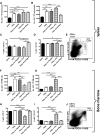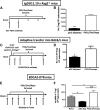Synergy between rapamycin and FLT3 ligand enhances plasmacytoid dendritic cell-dependent induction of CD4+CD25+FoxP3+ Treg
- PMID: 25833958
- PMCID: PMC4424416
- DOI: 10.1182/blood-2014-09-599266
Synergy between rapamycin and FLT3 ligand enhances plasmacytoid dendritic cell-dependent induction of CD4+CD25+FoxP3+ Treg
Abstract
CD4(+)CD25(+)FoxP3(+) regulatory T cells (Treg) are critical elements for maintaining immune tolerance, for instance to exogenous antigens that are introduced during therapeutic interventions such as cell/organ transplant or gene/protein replacement therapy. Coadministration of antigen with rapamycin simultaneously promotes deletion of conventional CD4(+) T cells and induction of Treg. Here, we report that the cytokine FMS-like receptor tyrosine kinase ligand (Flt3L) enhances the in vivo effect of rapamycin. This occurs via selective expansion of plasmacytoid dendritic cells (pDCs), which further augments the number of Treg. Whereas in conventional DCs, rapamycin effectively blocks mammalian target of rapamycin (mTOR) 1 signaling induced by Flt3L, increased mTOR1 activity renders pDCs more resistant to inhibition by rapamycin. Consequently, Flt3L and rapamycin synergistically promote induction of antigen-specific Treg via selective expansion of pDCs. This concept is supported by the finding that Treg induction is abrogated upon pDC depletion. The combination with pDCs and rapamycin is requisite for Flt3L/antigen-induced Treg induction because Flt3L/antigen by itself fails to induce Treg. As co-administering Flt3L, rapamycin, and antigen blocked CD8(+) T-cell and antibody responses in models of gene and protein therapy, we conclude that the differential effect of rapamycin on DC subsets can be exploited for improved tolerance induction.
© 2015 by The American Society of Hematology.
Figures







Similar articles
-
CD4+Foxp3+ regulatory T cells converted by rapamycin from peripheral CD4+CD25(-) naive T cells display more potent regulatory ability in vitro.Chin Med J (Engl). 2010 Apr 5;123(7):942-8. Chin Med J (Engl). 2010. PMID: 20497692
-
FLT3 ligand regulates expansion of regulatory T-cells induced by regulatory dendritic cells isolated from gut-associated lymphoid tissues through the Notch pathway.Chin Med J (Engl). 2025 Jul 5;138(13):1595-1606. doi: 10.1097/CM9.0000000000003493. Epub 2025 Apr 11. Chin Med J (Engl). 2025. PMID: 40211734 Free PMC article.
-
Rapamycin-conditioned dendritic cells are poor stimulators of allogeneic CD4+ T cells, but enrich for antigen-specific Foxp3+ T regulatory cells and promote organ transplant tolerance.J Immunol. 2007 Jun 1;178(11):7018-31. doi: 10.4049/jimmunol.178.11.7018. J Immunol. 2007. PMID: 17513751
-
Dendritic cells as controllers of antigen-specific Foxp3+ regulatory T cells.J Dermatol Sci. 2009 May;54(2):69-75. doi: 10.1016/j.jdermsci.2009.02.001. Epub 2009 Mar 14. J Dermatol Sci. 2009. PMID: 19286352 Free PMC article. Review.
-
Role of orally induced regulatory T cells in immunotherapy and tolerance.Cell Immunol. 2021 Jan;359:104251. doi: 10.1016/j.cellimm.2020.104251. Epub 2020 Nov 14. Cell Immunol. 2021. PMID: 33248367 Free PMC article. Review.
Cited by
-
Regulatory T cells in ischemic stroke.Acta Pharmacol Sin. 2022 Jan;43(1):1-9. doi: 10.1038/s41401-021-00641-4. Epub 2021 Mar 26. Acta Pharmacol Sin. 2022. PMID: 33772140 Free PMC article. Review.
-
Everolimus-Induced Immune Effects after Heart Transplantation: A Possible Tool for Clinicians to Monitor Patients at Risk for Transplant Rejection.Life (Basel). 2021 Dec 10;11(12):1373. doi: 10.3390/life11121373. Life (Basel). 2021. PMID: 34947904 Free PMC article.
-
Human Immune Responses to Adeno-Associated Virus (AAV) Vectors.Front Immunol. 2020 Apr 17;11:670. doi: 10.3389/fimmu.2020.00670. eCollection 2020. Front Immunol. 2020. PMID: 32362898 Free PMC article. Review.
-
Rapamycin Nano-Micelle Ophthalmic Solution Reduces Corneal Allograft Rejection by Potentiating Myeloid-Derived Suppressor Cells' Function.Front Immunol. 2018 Oct 8;9:2283. doi: 10.3389/fimmu.2018.02283. eCollection 2018. Front Immunol. 2018. PMID: 30349533 Free PMC article.
-
Effect of TGF-β1 on blood CD4+CD25high regulatory T cell proliferation and Foxp3 expression during non-small cell lung cancer blood metastasis.Exp Ther Med. 2018 Aug;16(2):1403-1410. doi: 10.3892/etm.2018.6306. Epub 2018 Jun 13. Exp Ther Med. 2018. PMID: 30112067 Free PMC article.
References
-
- Hackstein H, Taner T, Zahorchak AF, et al. Rapamycin inhibits IL-4–induced dendritic cell maturation in vitro and dendritic cell mobilization and function in vivo. Blood. 2003;101(11):4457–4463. - PubMed
-
- Matsue H, Yang C, Matsue K, Edelbaum D, Mummert M, Takashima A. Contrasting impacts of immunosuppressive agents (rapamycin, FK506, cyclosporin A, and dexamethasone) on bidirectional dendritic cell-T cell interaction during antigen presentation. J Immunol. 2002;169(7):3555–3564. - PubMed
Publication types
MeSH terms
Substances
Grants and funding
LinkOut - more resources
Full Text Sources
Other Literature Sources
Molecular Biology Databases
Research Materials
Miscellaneous

